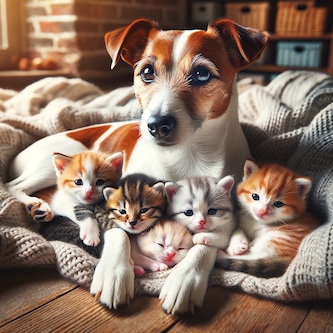A heartwarming story emerged in Newmarket when a dog, Teasel, took on the role of nursing and caring for a litter of abandoned kittens. The dog’s owner, Sue Stubley, initially planned to look after the kittens for a night before taking them to a local cat rescue. However, Teasel had other plans and began caring for the kittens, even producing milk to feed them.
Teasel’s maternal instincts extended beyond feeding and cleaning the kittens. She also showed protective behavior, picking up any stray kittens and returning them to their bed. This unusual behavior of a dog nurturing kittens is not unheard of, as there have been instances of cats and dogs adopting each other’s young, as well as other interspecies adoptions.
Biologist Dr. Rachel Grant explained that such interspecies adoptions are likely the result of “fixed action patterns,” where the adopting animal responds to specific triggers from the adoptee. These patterns elicit a cascade of behaviors in the brain, leading to maternal care. Dr. Grant also highlighted that the closer species are to one another, the more likely cross-species adoptions will occur.
While cross-species nursing is heartwarming, it challenges our understanding of evolution. Dr. Grant explained that such behaviors are driven by instinct and specific cues, which are not under conscious control. However, as long as these behaviors are successful most of the time, they are likely to be selected by evolution.
As for Teasel and the kittens, once weaning occurs, the bond between them is likely to lessen. However, all the kittens have new families lined up to give them homes, and Teasel’s strong maternal instincts will serve her well should she have her own pups in the future.
Original news source: Why did a dog in Newmarket end up nursing a litter of kittens? (BBC)
Listen
Slow
Normal
Fast
Group or Classroom Activities
Warm-up Activities:
– News Summary
Instructions: Pair up with a partner and take turns summarizing the heartwarming story of Teasel and the kittens using your own words. Try to condense the article into just five sentences, capturing the main points. Then, share your summaries with the class and discuss the differences in what details each pair considered most important.
– Opinion Spectrum
Instructions: Stand on a line in the classroom with one end representing ‘strongly agree’ and the other ‘strongly disagree’. The teacher will read statements related to the article, such as “Interspecies adoption is natural and should be encouraged” or “Maternal instincts are powerful enough to cross species barriers”. Students will place themselves along the line according to their opinion and then discuss their reasoning with the person standing next to them.
– Vocabulary Pictionary
Instructions: Split into two teams. Write down key terms from the article (e.g., “nursing”, “maternal instincts”, “fixed action patterns”, “interspecies adoption”, “evolution”) on slips of paper and place them in a bowl. Teams take turns drawing a slip and then one member has to illustrate the term without using words or gestures while their team guesses. Set a timer for each turn to make it more challenging.
– Think-Pair-Share
Instructions: Reflect on the article individually and think about the following question: “What implications does cross-species nursing have on our understanding of animal behavior and evolution?” After a few minutes, pair up with another student and share your thoughts. Finally, come together as a class and have a group discussion on the different viewpoints and insights.
– Future Predictions
Instructions: Discuss in small groups what you think will happen to the relationship between Teasel and the kittens as they grow older and once they have been adopted by new families. Consider the biological explanations provided in the article for maternal behavior and how this might influence their future interaction. Afterward, each group will present their predictions and reasoning to the class.
Comprehension Questions:
1. What did Teasel, the dog, do for the abandoned kittens in Newmarket?
2. What was Sue Stubley’s initial plan for the kittens before Teasel started caring for them?
3. How did Teasel demonstrate protective behavior towards the kittens?
4. What explanation does biologist Dr. Rachel Grant give for interspecies adoptions like Teasel’s?
5. According to Dr. Grant, what increases the likelihood of cross-species adoptions occurring?
6. Why does cross-species nursing challenge our understanding of evolution?
7. What is expected to happen to the relationship between Teasel and the kittens once weaning occurs?
8. What future plans have been made for the kittens, and how might Teasel’s maternal instincts benefit her in the future?
Go to answers ⇩
Listen and Fill in the Gaps:
A heartwarming story emerged in Newmarket when a dog, Teasel, took on the role of nursing and caring for a litter of abandoned kittens. The dog’s (1)______, Sue Stubley, initially planned to look after the kittens for a (2)______ before (3)______ them to a local cat rescue. However, Teasel had other plans and began caring for the kittens, even producing milk to feed them.
Teasel’s maternal (4)______ extended beyond feeding and cleaning the (5)______. She also showed protective behavior, picking up any stray kittens and returning them to their bed. This (6)______ behavior of a dog nurturing kittens is not unheard of, as there have been instances of cats and dogs adopting each (7)______’s young, as well as other interspecies adoptions.
Biologist Dr. Rachel (8)______ explained that such interspecies adoptions are likely the result of “fixed action patterns,” where the adopting animal responds to specific triggers from the (9)______. These patterns elicit a cascade of (10)______ in the brain, leading to maternal care. Dr. Grant also highlighted that the (11)______ (12)______ are to one another, the more likely cross-species adoptions will occur.
While cross-species nursing is heartwarming, it challenges our understanding of evolution. Dr. Grant explained that such behaviors are driven by instinct and specific cues, which are not under conscious control. However, as long as these behaviors are (13)______ most of the time, they are (14)______ to be selected by evolution.
As for Teasel and the kittens, once weaning occurs, the bond between them is likely to lessen. However, all the kittens have new families (15)______ up to give them homes, and Teasel’s strong maternal instincts will (16)______ her well should she have her own pups in the future.
Go to answers ⇩
Discussion Questions:
Students can ask a partner these questions, or discuss them as a group.
1. What is your personal view on animals adopting those of another species, and why do you feel that way?
2. Have you ever witnessed or heard about an animal displaying nurturing behavior towards another species? Can you share the story?
3. How would you feel if you saw a dog nursing kittens in real life? Would you be surprised or touched, and why?
4. Do you think that such instances of interspecies adoption challenge the traditional view of animal behavior? Why or why not?
5. What is a “fixed action pattern” in your own words, and can you think of any other examples where this might occur in the animal kingdom?
6. Do you like the idea of different animal species living together harmoniously? Why do you find it appealing or not?
7. How do you think the maternal instincts of animals like Teasel compare to those of humans? Are there any similarities or differences that stand out to you?
8. Do you believe that animals have emotions similar to humans, such as love and empathy, especially in cases like Teasel and the kittens?
9. What do you think drives an animal to care for young that are not their own? Is it purely instinctual, or could there be more to it?
10. How would you feel if you had to take care of an animal from a different species? Do you think you would be able to do it, and why?
11. Do you think that the bond formed between Teasel and the kittens will have a lasting impact on their behavior as they grow older? Why or why not?
12. Why do you think evolution might select for behaviors such as cross-species nursing, even though they are not the norm?
13. Do you think that stories like Teasel’s should be shared widely to promote the idea of compassion across species? Why or why not?
14. Have you ever had a pet that displayed protective or nurturing behavior towards you or another animal? Can you describe that experience?
15. Do you think that the kittens being raised by Teasel will exhibit any dog-like behaviors as they grow up, and why might that be interesting to observe?
Individual Activities
Vocabulary Meanings:
Match each word to its meaning.
Words:
1. nursing
2. abandoned
3. maternal
4. instincts
5. interspecies
6. evolution
7. weaning
8. pups
Meanings:
(a) The process of young animals becoming less dependent on their mother’s milk
(b) Relating to a mother’s role
(c) The process of change and development over time
(d) Involving different species
(e) Caring for someone, typically a baby or young animal
(f) Left behind, deserted
(g) Natural or inherent behavior
(h) Young dogs
Go to answers ⇩
Multiple Choice Questions:
1. What is the name of the dog who took on the role of nursing and caring for a litter of abandoned kittens?
(a) Daisy
(b) Teasel
(c) Max
(d) Buddy
2. What did the dog, Teasel, do to care for the abandoned kittens?
(a) Took them for walks
(b) Played fetch with them
(c) Produced milk to feed them
(d) Ignored them
3. What did Teasel do when she found any stray kittens?
(a) Ignored them
(b) Took them for a walk
(c) Played with them
(d) Returned them to their bed
4. According to biologist Dr. Rachel Grant, what triggers interspecies adoptions?
(a) Random chance
(b) Evolutionary pressure
(c) Human intervention
(d) Fixed action patterns
5. What did Dr. Grant say is likely to occur when weaning occurs between Teasel and the kittens?
(a) They will become even closer
(b) The bond between them is likely to lessen
(c) Teasel will adopt more kittens
(d) The kittens will leave Teasel for good
6. What did Dr. Grant say drives the behaviors of cross-species nursing?
(a) Instinct and specific cues
(b) Conscious control
(c) Human intervention
(d) Random chance
7. What did Dr. Grant say about behaviors like cross-species nursing in terms of evolution?
(a) They are not influenced by evolution
(b) They are detrimental to the survival of the species
(c) They are likely to be selected by evolution if they are successful
(d) They are purely random occurrences
8. What is likely to happen to the kittens once they are weaned?
(a) They have new families lined up to give them homes
(b) They will stay with Teasel forever
(c) They will be taken to a cat rescue
(d) They will be released into the wild
Go to answers ⇩
True or False Questions:
1. The closer species are to one another, the less likely cross-species adoptions will occur, according to Dr. Grant.
2. Teasel, a cat in Newmarket, ignored a litter of abandoned kittens, refusing to produce milk to feed them.
3. Once weaning occurs, the bond between Teasel and the kittens is likely to lessen, but all the kittens have new families lined up to give them homes.
4. Cross-species nursing challenges our understanding of evolution, as it is driven by instinct and specific cues rather than conscious control.
5. Biologist Dr. Rachel Grant explained that interspecies adoptions are likely the result of “fixed action patterns” triggering maternal care in the adopting animal.
6. Interspecies adoptions, such as a dog caring for kittens, are not unheard of and have been observed in other instances.
7. Teasel’s owner, Sue Stubley, initially planned to take the kittens to a local cat rescue, but Teasel refused to take on the role of nursing and caring for them.
8. Teasel showed neglectful behavior towards the kittens, ignoring any stray ones and leaving them alone.
Go to answers ⇩
Write a Summary:
Write a summary of this news article in two sentences.
Check your writing now with the best free AI for English writing!
Writing Questions:
Answer the following questions. Write as much as you can for each answer.
Check your answers with our free English writing assistant!
1. What unexpected behavior did Teasel the dog exhibit towards a litter of abandoned kittens?
2. How did biologist Dr. Rachel Grant explain the phenomenon of interspecies adoptions?
3. What are “fixed action patterns,” and how do they relate to Teasel’s behavior?
4. According to the article, what is the evolutionary significance of behaviors like Teasel’s?
5. What is the likely future for the bond between Teasel and the kittens after they are weaned?
Answers
Comprehension Question Answers:
1. What did Teasel, the dog, do for the abandoned kittens in Newmarket?
Teasel took on the role of nursing and caring for the abandoned kittens, even producing milk to feed them, cleaning them, and showing protective behavior.
2. What was Sue Stubley’s initial plan for the kittens before Teasel started caring for them?
Sue Stubley’s initial plan was to look after the kittens for a night before taking them to a local cat rescue.
3. How did Teasel demonstrate protective behavior towards the kittens?
Teasel demonstrated protective behavior by picking up any stray kittens and returning them to their bed.
4. What explanation does biologist Dr. Rachel Grant give for interspecies adoptions like Teasel’s?
Dr. Rachel Grant explains that interspecies adoptions are likely the result of “fixed action patterns,” where the adopting animal responds to specific triggers from the adoptee, leading to maternal care.
5. According to Dr. Grant, what increases the likelihood of cross-species adoptions occurring?
The closer species are to one another, the more likely cross-species adoptions will occur.
6. Why does cross-species nursing challenge our understanding of evolution?
Cross-species nursing challenges our understanding of evolution because it is driven by instinct and specific cues that are not under conscious control, yet these behaviors are selected by evolution as long as they are successful most of the time.
7. What is expected to happen to the relationship between Teasel and the kittens once weaning occurs?
Once weaning occurs, the bond between Teasel and the kittens is likely to lessen.
8. What future plans have been made for the kittens, and how might Teasel’s maternal instincts benefit her in the future?
All the kittens have new families lined up to give them homes, and Teasel’s strong maternal instincts will serve her well should she have her own pups in the future.
Go back to questions ⇧
Listen and Fill in the Gaps Answers:
(1) owner
(2) night
(3) taking
(4) instincts
(5) kittens
(6) unusual
(7) other
(8) Grant
(9) adoptee
(10) behaviors
(11) closer
(12) species
(13) successful
(14) likely
(15) lined
(16) serve
Go back to questions ⇧
Vocabulary Meanings Answers:
1. nursing
Answer: (e) Caring for someone, typically a baby or young animal
2. abandoned
Answer: (f) Left behind, deserted
3. maternal
Answer: (b) Relating to a mother’s role
4. instincts
Answer: (g) Natural or inherent behavior
5. interspecies
Answer: (d) Involving different species
6. evolution
Answer: (a) The process of young animals becoming less dependent on their mother’s milk
7. weaning
Answer: (c) The process of change and development over time
8. pups
Answer: (h) Young dogs
Go back to questions ⇧
Multiple Choice Answers:
1. What is the name of the dog who took on the role of nursing and caring for a litter of abandoned kittens?
Answer: (b) Teasel
2. What did the dog, Teasel, do to care for the abandoned kittens?
Answer: (c) Produced milk to feed them
3. What did Teasel do when she found any stray kittens?
Answer: (d) Returned them to their bed
4. According to biologist Dr. Rachel Grant, what triggers interspecies adoptions?
Answer: (d) Fixed action patterns
5. What did Dr. Grant say is likely to occur when weaning occurs between Teasel and the kittens?
Answer: (b) The bond between them is likely to lessen
6. What did Dr. Grant say drives the behaviors of cross-species nursing?
Answer: (a) Instinct and specific cues
7. What did Dr. Grant say about behaviors like cross-species nursing in terms of evolution?
Answer: (c) They are likely to be selected by evolution if they are successful
8. What is likely to happen to the kittens once they are weaned?
Answer: (a) They have new families lined up to give them homes
Go back to questions ⇧
True or False Answers:
1. The closer species are to one another, the less likely cross-species adoptions will occur, according to Dr. Grant. (Answer: False)
2. Teasel, a cat in Newmarket, ignored a litter of abandoned kittens, refusing to produce milk to feed them. (Answer: False)
3. Once weaning occurs, the bond between Teasel and the kittens is likely to lessen, but all the kittens have new families lined up to give them homes. (Answer: True)
4. Cross-species nursing challenges our understanding of evolution, as it is driven by instinct and specific cues rather than conscious control. (Answer: True)
5. Biologist Dr. Rachel Grant explained that interspecies adoptions are likely the result of “fixed action patterns” triggering maternal care in the adopting animal. (Answer: True)
6. Interspecies adoptions, such as a dog caring for kittens, are not unheard of and have been observed in other instances. (Answer: True)
7. Teasel’s owner, Sue Stubley, initially planned to take the kittens to a local cat rescue, but Teasel refused to take on the role of nursing and caring for them. (Answer: False)
8. Teasel showed neglectful behavior towards the kittens, ignoring any stray ones and leaving them alone. (Answer: False)
Go back to questions ⇧













